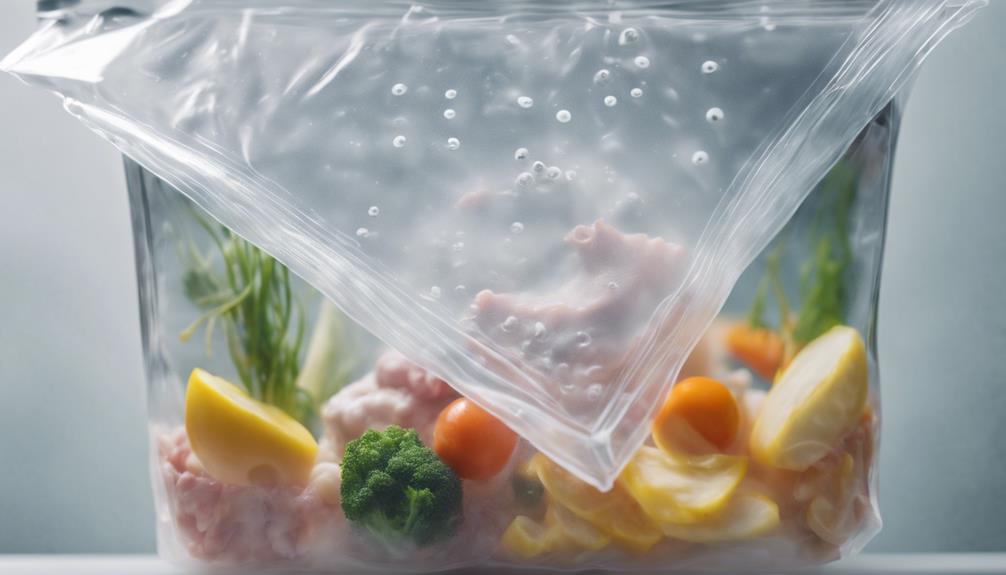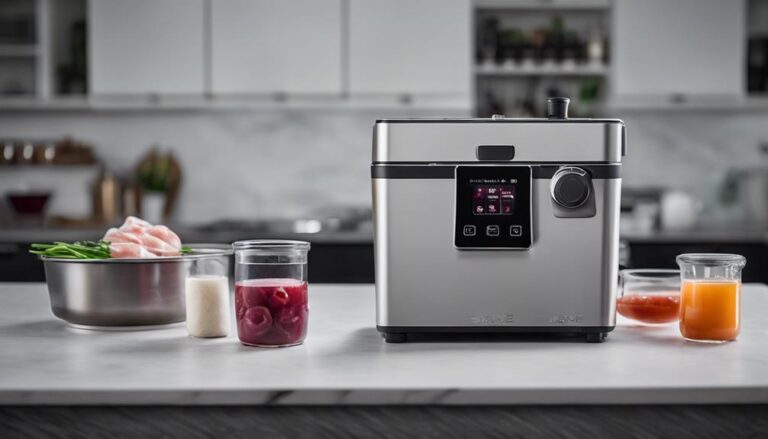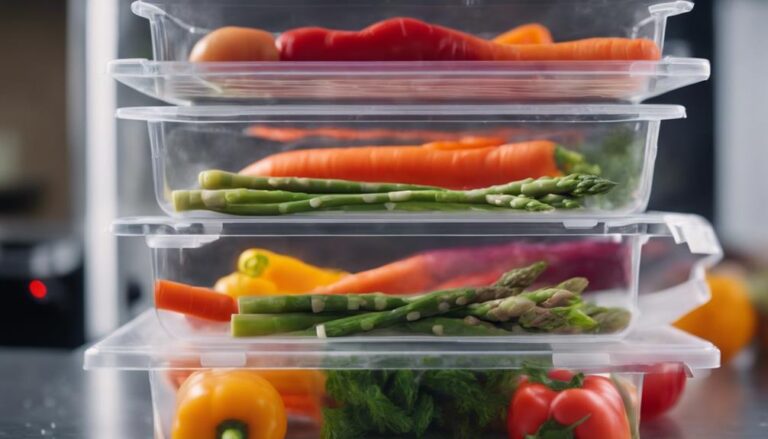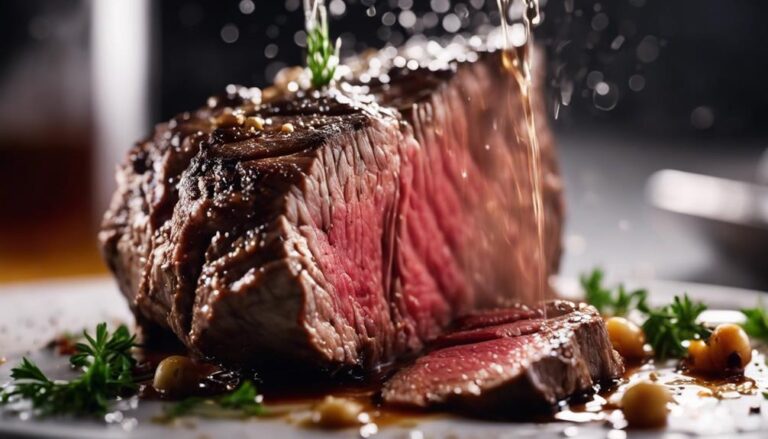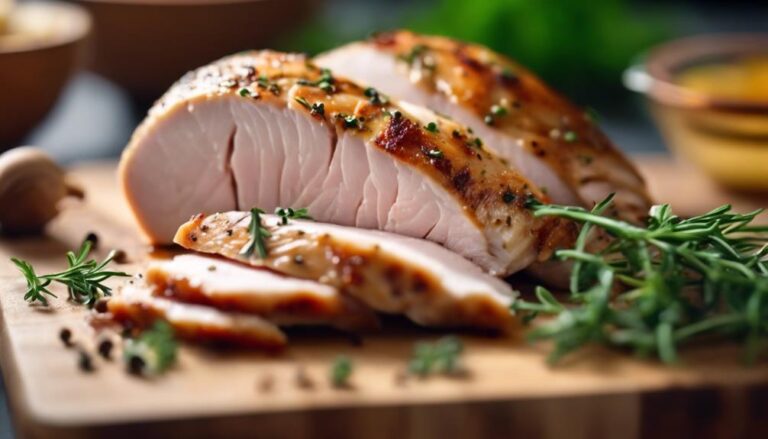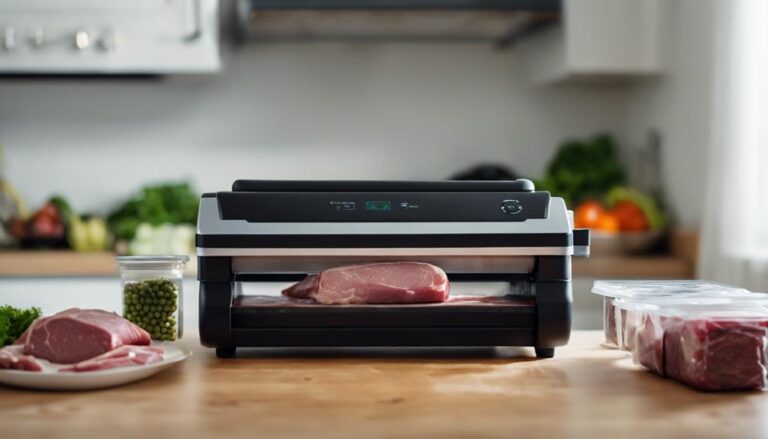Preventing Water Evaporation: A Guide to Long Sous Vide Cooks
To nail long sous vide cooks, you must prevent water evaporation. Control water levels precisely for efficient heat distribution and consistent temperatures. Insulate your setup well to trap heat and maintain a steady cooking environment. Use essential lid covers to retain heat and reduce evaporation—they're essential for extended cooking sessions. Track water levels during cooking, replenishing as needed. Top up water regularly, experiment with insulation, and use ping pong balls to lower evaporation. Seal bags right, manage temperature accurately, and voilà! Keep honing these techniques for perfect sous vide results.
What You Will Learn Here
- Insulate your setup to minimize heat loss and maintain a consistent cooking environment.
- Use lid covers effectively to maximize heat retention and prevent water evaporation.
- Monitor water evaporation progress to ensure successful long cooks.
- Additional tips include insulating containers, using ping pong balls, and sealing bags properly.
- Ensure precise temperature regulation for food safety during long sous vide cooks.
Importance of Water Level Control
Maintaining the accurate water level is essential in sous vide cooking to prevent evaporation. This is critical for ensuring efficient water circulation and maintaining temperature stability throughout the cooking process. By keeping a close eye on the water level in your sous vide setup, you can guarantee that your food cooks evenly and precisely.
Proper water circulation is key to distributing heat evenly around your ingredients, resulting in perfectly cooked dishes. Without sufficient water in the cooking vessel, the circulation may be disrupted, leading to uneven cooking and potentially undercooked food. Ensuring the water level remains consistent allows the circulator to function at its best, providing the necessary heat to cook your meals to perfection.
Moreover, maintaining the water level helps to stabilize the temperature inside the cooking vessel. Fluctuations in water level can cause variations in temperature, which may result in inconsistent cooking outcomes. By controlling the water level, you can create an ideal environment for your food to cook evenly and retain its flavors.
Insulating Your Sous Vide Setup
To enhance efficiency and precision in your sous vide cooking, consider insulating your setup to minimize heat loss and maintain a consistent cooking environment. Heat retention is vital for achieving perfectly cooked meals, especially during long sous vide cooks. Using insulation techniques such as wrapping your container in towels or using a sous vide sleeve can help trap the heat and prevent temperature fluctuations.
Insulating your sous vide setup not only conserves energy but also guarantees that your food cooks evenly. By reducing heat loss, you can maintain the water temperature more effectively, resulting in a stable cooking environment throughout the cooking process. This is particularly important for recipes that require extended cooking times.
Experiment with different insulation methods to find what works best for your setup. Whether it's using insulating materials like foam boards or creating a DIY insulated lid, finding the right balance of heat retention and insulation will elevate your sous vide cooking experience. Remember, a well-insulated setup is key to achieving consistent and delicious results every time.
Using Lid Covers Effectively
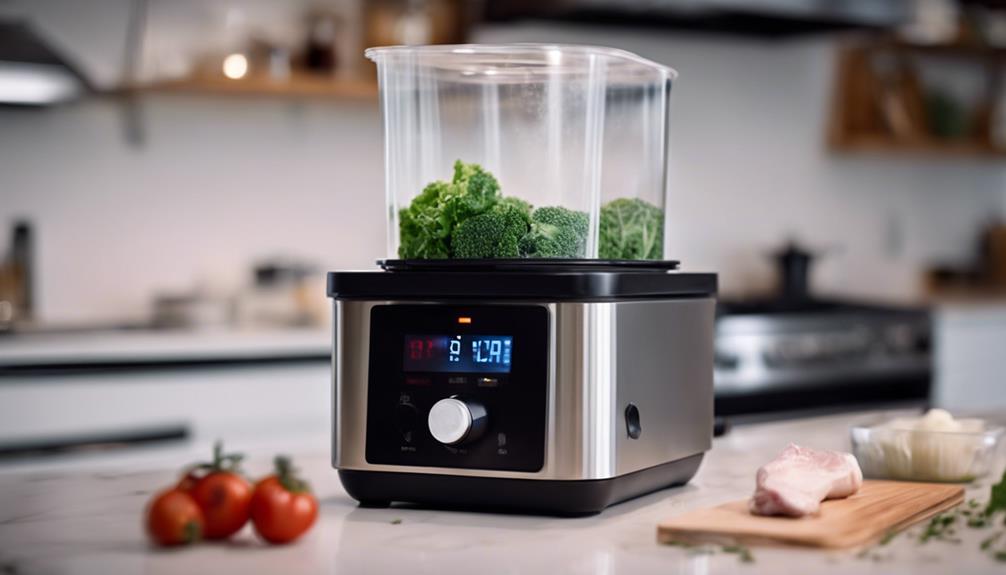
For peak heat retention and water evaporation prevention in sous vide cooking, maximize the efficiency of your setup by strategically utilizing lid covers. Proper lid maintenance is key to guaranteeing a tight seal that traps heat within the water bath, allowing your food to cook evenly while conserving energy. Here are some tips to help you make the most of your lid covers:
| Benefits of Lid Covers | Tips for Effective Use |
|---|---|
| Heat retention | Ensure lids fit securely on containers to prevent heat loss. |
| Water evaporation prevention | Use insulated lids to minimize evaporation during long cooks. |
| Improved cooking results | Check lids regularly for cracks or damage that may impact performance. |
| Energy efficiency | Clean lids thoroughly after each use to maintain their effectiveness. |
| Time-saving | Invest in reusable silicone lids for a sustainable and convenient option. |
Monitoring Water Evaporation Progress
Keep an eye on water levels during sous vide cooking to track the progress of evaporation. Monitoring water loss is essential for successful long cooks. By regularly checking the water level in your sous vide container, you can guarantee that it remains at the ideal level throughout the cooking process.
To prevent excessive evaporation, consider using evaporation prevention techniques such as covering your container with a lid or using a sous vide container with a tight-fitting lid. These methods help trap the steam generated during cooking, reducing water loss and maintaining a consistent water level.
During extended cooking times, water evaporation can be more pronounced. By monitoring the water level periodically, you can replenish it as needed to prevent any disruptions to the cooking process. This simple step can help you achieve perfect results and ensure that your food cooks evenly and thoroughly. Stay vigilant and attentive to the water levels to master the art of long sous vide cooks.
Additional Tips for Long Cooks

Consider covering your sous vide container with a tight-fitting lid to minimize water evaporation and maintain ideal cooking conditions for long cooks. To guarantee precise temperature regulation and food safety during extended sous vide cooking sessions, here are some additional tips:
| Additional Tips | Description |
|---|---|
| Insulate container | Wrap your container with towels or use an insulating sleeve to help retain heat. |
| Monitor water level | Regularly check the water level and top up with hot water to compensate for evaporation. |
| Use ping pong balls | Placing ping pong balls on the water surface creates a barrier that reduces evaporation. |
| Seal bags properly | Double-check that your vacuum-sealed bags are completely airtight to prevent water ingress. |
Frequently Asked Questions
Are There Any Specific Types of Containers or Vessels That Are Better for Preventing Water Evaporation During Long Sous Vide Cooks?
For long sous vide cooks, the best materials for preventing water evaporation are insulated containers or vessels. Consider using containers with thick walls or double-walled insulation. These choices help maintain water levels and cooking temperatures effectively.
Can Adding Certain Ingredients to the Water Help Reduce Evaporation Rates?
To reduce evaporation rates during long sous vide cooks, adding certain ingredient additives can help. Additionally, maintaining precise temperature control, selecting the right vessel, and adjusting the water level as needed are effective strategies for preventing water loss.
Is It Necessary to Adjust the Water Level Throughout the Cooking Process, or Can It Be Set at the Beginning and Left Alone?
You should monitor the water level during cooking. Adjustments may be needed to maintain the appropriate level. Avoid the "set it and forget it" mindset when it comes to ensuring a consistent cooking environment in sous vide preparation.
How Does the Ambient Temperature of the Room Affect Water Evaporation in a Sous Vide Setup?
In a sous vide setup, the ambient temperature of the room affects water evaporation. Insulation helps maintain stable temperatures, reducing evaporation. Keeping water levels at the ideal level minimizes evaporation, preserving your cooking environment and ensuring consistent results.
Are There Any Specific Times During the Cooking Process Where Water Evaporation Tends to Increase, and How Can This Be Mitigated?
During long sous vide cooks, water evaporation tends to increase when lid options are not utilized or due to temperature fluctuations. To mitigate this, consider using insulation techniques and choosing a proper lid to control evaporation.
Conclusion
So there you have it – by keeping a close eye on water levels, insulating your setup, using lid covers, and monitoring progress, you can prevent water evaporation during long sous vide cooks.
With these tips in mind, you can enjoy perfectly cooked meals without the worry of losing water and affecting the cooking process.
Happy sous vide cooking!
